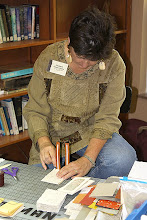I had the pleasure of presenting my research in papermaking from garden plants and the crops of Madison County to the Southwestern Illinois Hemerocallis Society last evening. Since I knew there were teachers in the Society, my presentation focused on both the process and the interdisciplinary connections made in the classroom.
While the powerpoint images depicting the stages of papermaking from harvesting in the garden to the classroom and studio clearly defined the process, the members and their guests made tangible connections when they finally held my handmade books and closely inspected the construction of my handmade paper landscapes of Cornwall.
 |
| Sun Pans and Mica Drags |
After carefully examining my landscapes, one member of the Society was excited to share that his grandparents came from Cornwall; and he had been to Liskeard, Cornwall for a family reunion!
The following is a short description from last night's program:
This presentation explores papermaking from plants as a means of experiencing real world interdisciplinary connections between the art studio or classroom and the local organic environment (farms or gardens). By growing and/or harvesting the waste materials (stems, stalks, vines, or leaves) of local crops or landscape plants, processing the pulp, and transforming the pulp into paper for painting, drawings, printing, sculpture, or bookbinding, art students will work together to explore chemistry, botany, agriculture, math, and the history of papermaking, while expanding their critical thinking, planned risk taking, self-motivation, creativity, responsibility, teamwork, time management, interpersonal communication, and a sense of self-worth gained for meeting or exceeding expectations. The presentation will offer step-by-step detailed descriptions and images of the process of papermaking from plants, as well as actual samples of handmade paper and books for teachers who desire art as experience from seed to final binding stitch.











